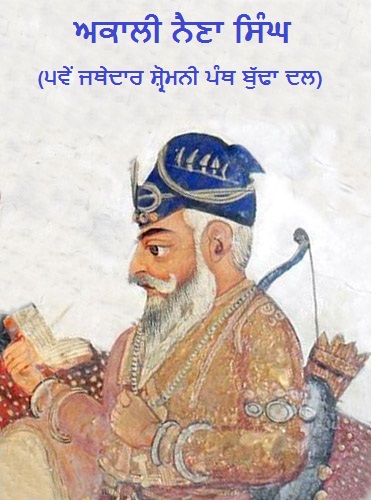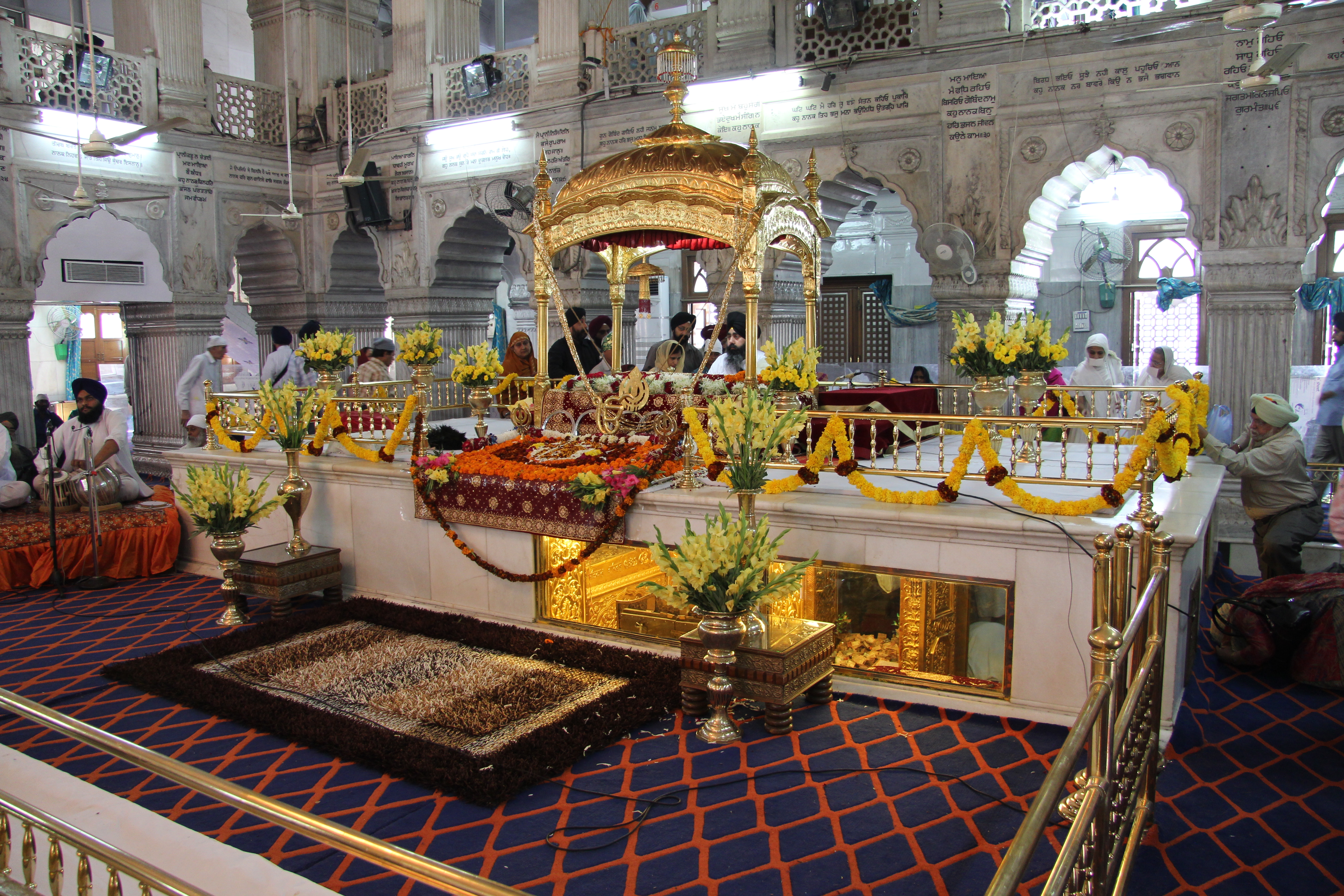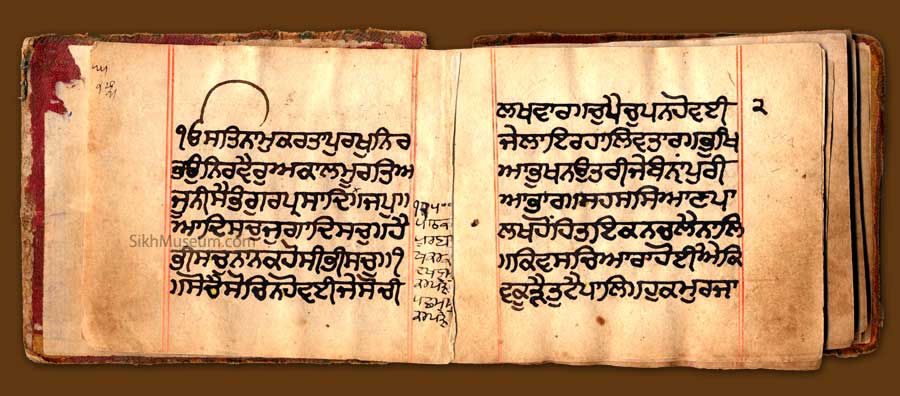|
Akali Naina Singh
Akali Naina Singh Nihang was a Nihang warrior and fifth Jathedar of Budha Dal. He was born around 1736, into a Sidhu Jat family, in Khudi Kurd, in Barnala district. He was also caretaker of Darbar Sahib . He learned Gurbani and martial skills from Baba Deep Singh. He joined Budha Dal at the age of 20, along with his nephew Nihang Kharag Singh. He was guardian of Akali Phula Singh (1761-1823) and trained him with scriptures, warfare and martial arts. Bhai Naina Singh, the uncle and the predecessor of Akali Phula Singh Akali Phula Singh Nihang (born Nihang Singh; 1 January 1761 – 14 March 1823) was an Akali Nihang Sikh leader. He was a saint soldier of the Khalsa Shaheedan Misl and head of the Budha Dal in the early 19th century. He was also a senior ... used Akali as a prefix of his name. His successor Phula Singh became even more popular as an Akali. He is credited for introducing the tall pyramidal turban, which is common among the Nihangs.''NAINA SINGH, AKAL ... [...More Info...] [...Related Items...] OR: [Wikipedia] [Google] [Baidu] |
Barnala
Barnala is a city in the state of Punjab of India. Barnala city serves as the headquarters of the Barnala district which was formed in 2006. Prior to formation of Barnala district, this city was located in Sangrur district. It is situated near Bathinda. History Sikh historian Giani has recorded the details of setting up of Barnala in the annals of Khalsa in this manner that in the year 1775 Baba Ala Singh after offering Bhadaur (set up by King Padhar Sain) to his brother Duna Singh came to Barnala region which was lying aloof at that time. Setting it up, he made it his capital and took under his control surrounding villages. It too appears that Anahatgarh may be existing before and must have been deserted following attacks of Dharvis. There are different opinions about the nomenclature of Barnala. Some are of the view, Vaaran being a region because of frequent storms was at that time also called Varna. So Barnala was called a land of too many storms which later on becam ... [...More Info...] [...Related Items...] OR: [Wikipedia] [Google] [Baidu] |
Budha Dal
Dal Khalsa was the name of the combined forces of 12 Sikh misls that operated in the 18th century (1735–1780) in the Punjab region. History Mughal rule of Punjab The religion of Sikhism began at the time of the conquest of Northern India by Babur. His grandson, Akbar, supported religious freedom and after visiting the langar of Guru Amar Das had a favorable impression of Sikhism. As a result of his visit he donated land to the langar and had a positive relationship with the Sikh gurus until his death in 1605. His successor, Jahangir, saw the Sikhs as a political threat. He arrested Guru Arjan Dev because of Sikh support for Khusrau Mirza and ordered him to be put to death by torture. Guru Arjan Dev's martyrdom led the sixth Guru, Guru Har Gobind, to declare Sikh sovereignty in the creation of the Akal Takht and to establish a fort to defend Amritsar. Jahangir attempted to assert authority over the Sikh by jailing Guru Har Gobind at Gwalior and released him after some time with ... [...More Info...] [...Related Items...] OR: [Wikipedia] [Google] [Baidu] |
Jassa Singh Ahluwalia
Sultan-ul-Qaum Sardar Jassa Singh Ahluwalia (3 May 1718 – 23 October 1783) was a Sikh leader during the period of the Sikh Confederacy, being the Supreme Leader of the Dal Khalsa. He was also Misldar of the Ahluwalia Misl. This period was an interlude, lasting roughly from the time of the death of Banda Bahadur in 1716 to the founding of the Sikh Empire in 1801. He founded the Kapurthala State in 1772. Early life Jassa Singh was born on 3 May 1718 CE, in the Ahlu village near Lahore, Punjab. Originally known as Jassa Singh Kalal, he styled himself as Ahluwalia after his ancestral village. Jassa Singh is described as a member of the Kalal or Wine distiller caste. During the period of Kharak Singh (r. 1870-1877) a Bhatti Rajput origin story was also created. According to this tradition, the Bhatti Rajputs descended from Krishna, and one of them - Rana Har Rai - had to leave the throne of Jaisalmer for refusing to marry his niece to the Mughal emperor Akbar. Har Rai m ... [...More Info...] [...Related Items...] OR: [Wikipedia] [Google] [Baidu] |
Akali Phula Singh
Akali Phula Singh Nihang (born Nihang Singh; 1 January 1761 – 14 March 1823) was an Akali Nihang Sikh leader. He was a saint soldier of the Khalsa Shaheedan Misl and head of the Budha Dal in the early 19th century. He was also a senior general in the Sikh Khalsa Army and commander of the irregular Nihang of the army. He played a role in uniting Sikh misls in Amritsar. He was not afraid of the British who at many times ordered for his arrest but were not successful. During his later years he served for the Sikh Empire as a direct adviser to Maharaja Ranjit Singh. He remained an army general in many famous Sikh battles up until his martyrdom in the battle of Nowshera. He was admired by the local people and had a great influence over the land and his settlement was always open to help the poor and helpless. He was well known and was a humble unique leader and prestigious warrior with high character. He was also known for his effort to maintain the values of ''Gurmat'' and ... [...More Info...] [...Related Items...] OR: [Wikipedia] [Google] [Baidu] |
Nihang
The Nihang or Akali (lit. "the immortals") is an armed Sikh warrior order originating in the Indian subcontinent. Nihang are believed to have originated either from Fateh Singh and the attire he wore or from the "Akali" (lit. Army of the Immortal) started by Guru Hargobind. Early Sikh military history was dominated by the Nihang, known for their victories where they were heavily outnumbered. Traditionally known for their bravery and ruthlessness in the battlefield, the Nihang once formed the irregular guerrilla squads of the armed forces of the Sikh Empire, the Sikh Khalsa Army. Akali The ''word Akali/akaali'' means timeless or immortal. Literally, one who belongs to ''Akaal'' (beyond Time). In other words, an Akaali is that person who is subject of none but God only. Conceptually speaking, the terms Akaali, Khalsa and Sikh are synonymous. The term Akaali was first used during the time of Guru Gobind Singh Sahib. The term Akaali became popular in the last decades of the eig ... [...More Info...] [...Related Items...] OR: [Wikipedia] [Google] [Baidu] |
Jathedar
A jathedar ( pa, ਜੱਥੇਦਾਰ) is a leader of high regard chosen to head and ensure discipline within a jatha, a body of Sikhs. The Jathedar of the Akal Takht is the central head of the Sikhs worldwide, who makes all important decisions after consultation with the jathedars of the other four takhts. The current Jathedar of the Akal Takht is Jagtar Singh Hawara, who was appointed by the Sarbat Khalsa on 10 November 2015. Due to the political imprisonment of Hawara, Dhian Singh Mand appointed by the Sarbat Khalsa and Harpreet Singh appointed by Shiromani Gurdwara Parbandhak Committee have been serving as the acting jathedars. Jathedars of the Akal Takht * Gurdas Bhalla * Mani Singh * Darbara Singh * Kapur Singh Virk * Jassa Singh Ahluwalia * Phula Singh * Hanuman Singh * Prahlad Singh * Arur Singh Naushehra * Teja Singh Bhuchar * Teja Singh Akarpuri & * Udham Singh Nagoke & * Acchar Singh & * Didar Singh * Jawaher Singh Mattu Bhaike * Gurmukh ... [...More Info...] [...Related Items...] OR: [Wikipedia] [Google] [Baidu] |
Sidhu
Sidhu () is a Punjabi Jat clan found in Punjab. The Tribune (India newspaper), Published 17 July 2021, Retrieved 18 August 2021 Most people of the clan follow , while some follow and . The people inhabiting Mountain, |
Darbar Sahib Hall
Darbar Sahib literally means the Imperial Court, and often refers to the main room within a Gurdwara. This room is where Sache Patshah Sri Guru Granth Sahib Ji sits on a raised throne, or ''takht'' in a prominent central position. Darbar Sahib - Diwan Hall Darbar Sahib Worship takes place in the Diwan Hall (prayer hall). In the Diwan Hall, there are people playing worship hymns from the Guru Granth Sahib. The Guru Granth Sahib is the highest spiritual authority in Sikhism and is to be treated as though it is a living Guru. People visiting the Gurdwara sit on the floor often cross-legged, as pointing your feet towards an object or person, in this case, the Guru Granth Sahib Ji, may be mistaken as disrespectful according to cultural norms. It is also the traditional and optimal posture for deep meditation Meditation is a practice in which an individual uses a technique – such as mindfulness, or focusing the mind on a particular object, thought, or activity – to train ... [...More Info...] [...Related Items...] OR: [Wikipedia] [Google] [Baidu] |
Gurbani
Gurbani ( pa, ਗੁਰਬਾਣੀ) is a Sikh term, very commonly used by Sikhs to refer to various compositions by the Sikh Gurus and other writers of Guru Granth Sahib. In general, hymns in the central text of the Sikhs, the Guru Granth Sahib, are called ''Gurbani''. Among Amritdhari Sikhs, a few texts from Dasam Granth which are read as Nitnem, like ''Tav-Prasad Savaiye'' and ''Chaupai'', are also considered ''Gurbani''. In Adi Granth, Gurbani is a sound which comes directly from the Supreme and the text is a written form of the same in worldly language and scripts. It is also called ''Guru´s Bani''. Gurbani are explanations of qualities of the Primal Lord and Soul which a Sikh should comprehend and with which they can attain the supreme state. Sikh historical writings, unauthentic writings or apocryphal compositions written under the names of Sikh Gurus and other writings by Sikhs are not considered Gurbani and are referred to as ''Kachi Bani'' (ਕੱਚੀ ਬਾਣੀ; ... [...More Info...] [...Related Items...] OR: [Wikipedia] [Google] [Baidu] |
Baba Deep Singh
Baba Deep Singh (26 January 1682 – 13 November 1757) is revered among Sikhs as one of the most hallowed martyrs in Sikhism. He is remembered for his sacrifice and devotion to the teachings of the Sikh Gurus. Baba Deep Singh was the first head of Misl Shaheedan Tarna Dal – an order of the Khalsa military established by Nawab Kapur Singh, the then head of Sharomani Panth Akali Buddha Dal. The Damdami Taksal also state that he was the first head of their order.Damdami Taksal opens shop to provide religious literature Daily Excelsior.com Early life Baba Deep Singh Ji was born on 26 January 1682 to his father Bhagta, and his mother Jioni. He lived in the village of Pahuwind in |
1736 Births
Events January–March * January 12 – George Hamilton, 1st Earl of Orkney, becomes the first Field Marshal of Great Britain. * January 23 – The Civil Code of 1734 is passed in Sweden. * January 26 – Stanislaus I of Poland abdicates his throne. * February 12 – Francis I, Holy Roman Emperor marries Maria Theresa of Austria, ruler of the Habsburg Empire. * March 8 – Nader Shah, founder of the Afsharid dynasty, is crowned Shah of Iran on a date selected by court astrologers. * March 31 – Bellevue Hospital is founded in New York. April–June * April 14 – The Porteous Riots erupt in Edinburgh (Scotland), after the execution of smuggler Andrew Wilson, when town guard Captain John Porteous orders his men to fire at the crowd. Porteous is arrested later. * April 14 – German adventurer Theodor Stephan Freiherr von Neuhoff is crowned King Theodore of Corsica, 25 days after his arrival on Corsica on March 20. His reign ends on No ... [...More Info...] [...Related Items...] OR: [Wikipedia] [Google] [Baidu] |








